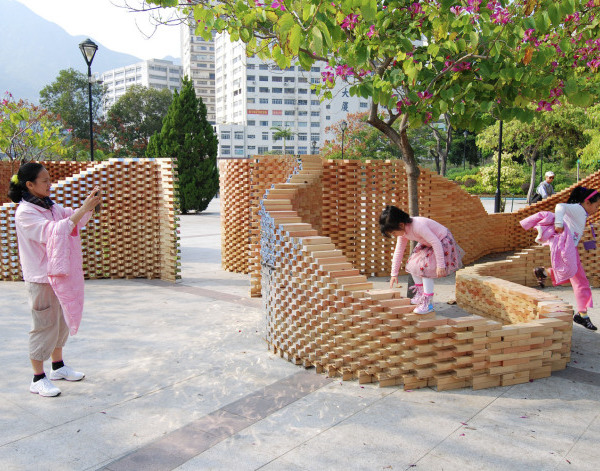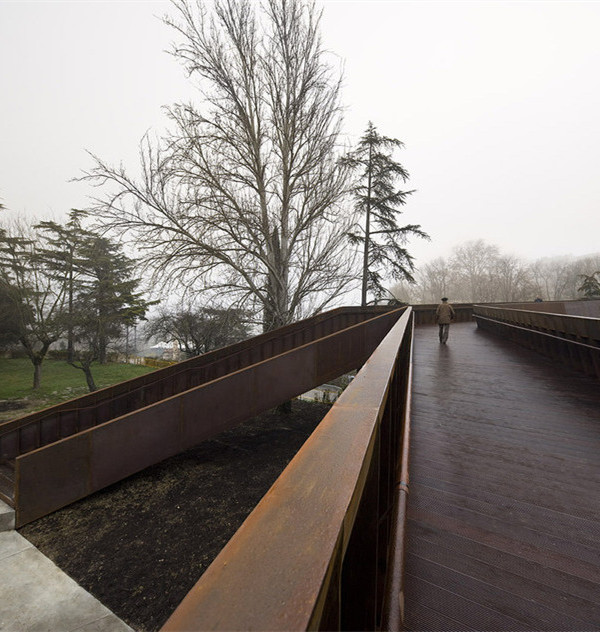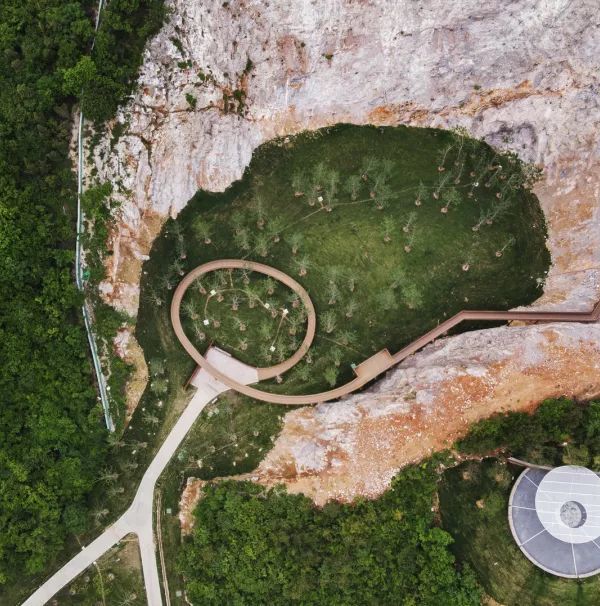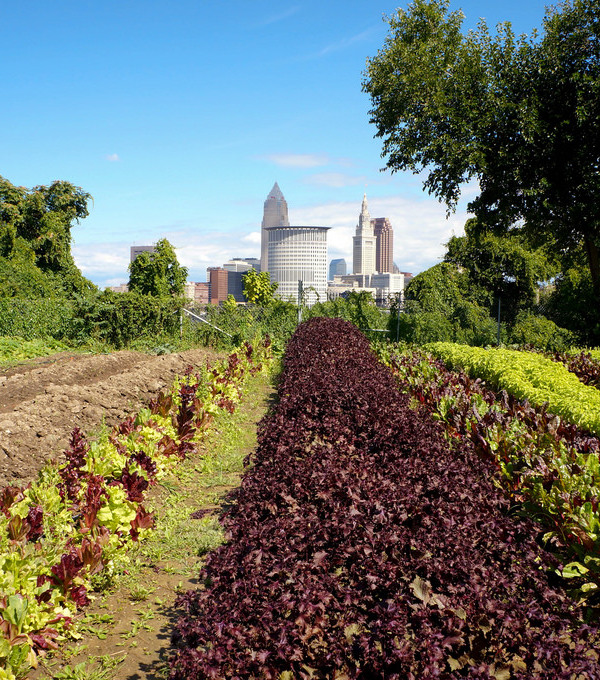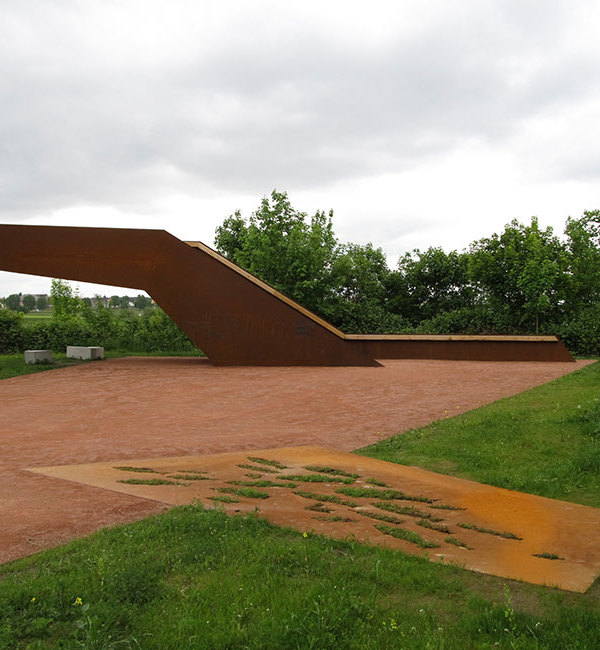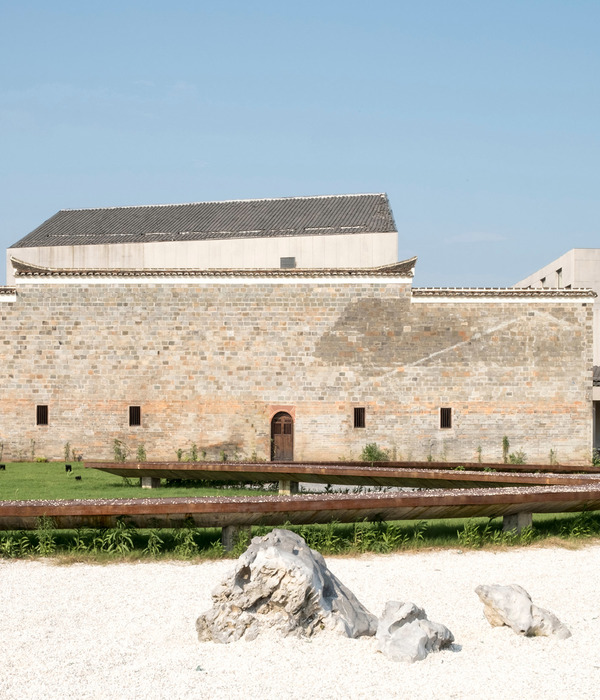目标
Objective
Krasnogvardeisky池塘是历史悠久的Krasnaya Presnya公园的景观延续。项目的主要目标是将两个公园整合在一起,使这片广阔的自然景观与公共空间迎合社会和城市的综合发展。设计旨在尽可能地保留Krasnogvardeisky池塘公园的现有结构和景观,同时将该公园打造为适合家庭活动的舒适休闲场所。
Krasnogvardeisky ponds are a historical continuation of the main territory of the Krasnaya Presnya Park. Merging these two parks into a single system led to an integrated development programme based on a broad social and urban research. Preserving the existing structure and landscape of the Krasnogvardeisky ponds parks as much as possible, required for a comfortable family type and active recreation space to be created.
▼项目概览,overall of the project
解决方法
Solution
设计概念的发展基于KB23研究所进行的社会学研究。该研究采纳了附近居民的反馈,为平衡公园的娱乐功能与空间形式提供了坚实可靠的依据,并在项目最初就为该场地提出了“僻静的内庭院”的定义。设计任务的重要部分在于将公园的历史文脉与当地社区的利益相结合,以高品质的景观空间展现社区的身份。
▼亲水平台,platform along the pound
Krasnogvardeisky池塘场地,由三个沿着居民区延伸的、相互连接的池塘组成。这些池塘形成于18世纪早期,是Gagarin Studenets王子庄园公园的一部分。20世纪50年代后期,公园的形式随着场地上林荫大道的规划而逐渐形成。“红色历史”是公园景观概念设计中提取的重要象征元素之一。池塘的名字“Krasnogvardeisky”代表了“红卫兵”,彰显出该场地的历史与二十世纪初的革命历史密不可分。除了受到早期苏联美学的影响外,设计还需要一个醒目的元素将居民吸引到这个狭长隐秘的场地中,因此,红色不出意外地成为了新公园的代表色。
The territory of the Krasnogvardeisky ponds consists of a cascade of three interconnected ponds stretched along the residential area. The ponds were formed back in the early XVIII century as a part of the princes Gagarin Studenets estate park ensemble. The territory acquired its present form in the late 50s of the XX century during the development of the boulevard. One of the important symbolic meanings which had formed the prospect concept of the park is its Red history. Since the Ponds’ name stands for the Red Guardy’s Ponds, the park’s identity is inseparable from the revolutionary history of the early XX Century. Both the inevitable touch of early Soviet aesthetics and the need of architects to make a narrow hidden area look inviting for the residents resulted in red colour appearing to be the main in the colour chart of the new park.
▼分析图,analysis diagram
为了将Krasnogvardeisky池塘与周边Krasnaya Presnya公园的自然景观整合在一起,Wowhaus事务所为场地中添加的所有新元素制定了统一的设计语言,导航系统,以及视觉标识。所有景观小品都采用了轻盈的网格结构,以及高耸挺拔的空间形态,并采取了统一的、由红色、黑色以及天然木材肌理构成的配色方案。
Wowhaus created a development project for the Krasnogvardeisky ponds territory and their natural integration with the nearest Krasnaya Presnya Park using a general navigation, design identity, design codes for new objects and infrastructure. All objects incorporate a common design of soaring structures with lightweight grid elements, the colour scheme is also unified and consists of red, anthracite-coloured and the colour of natural wood.
▼由红色、黑色以及天然木材肌理构成的统一配色方案,colour scheme is also unified and consists of red, anthracite-coloured and the colour of natural wood
设计另一重要目标旨在增强公共空间与水的联系。因此,池塘内的杂物都被清理干净,岸边的灌木丛也得到了修整。此外,设计师还将多年生植物添加到公园现有的植被生态系统中,以强调出Krasnogvardeisky池塘的自然之美。而活动区与池塘之间的过渡地带则种满了专门为该地区选择的各种灌木与草本植物。
Another crucial object of the project was to reinforce interaction with the water, so the ponds were cleared of debris and thickets. Particular attention was paid to the additional landscaping of the territory. Perennial plants were added to the existing fabric of greenery designed to emphasize the natural beauty of the Krasnogvardeisky ponds and also create a missing middle tier consisting of various shrubs and plants specially selected for this area.
▼丰富的休息设施,abundant rest facilities
五个主要片段
Five Fragments
根据公园的历史文脉、整体设计、周边住宅区,以及附近的各种城市元素,公园场地被分为五个主要组成部分。此外,从社会学资料来看,公园在历史上已经形成了具有一定功能划分的地形特征。在此次景观改造前,公园内或多或少已自然形成了一些安静区、社交区,或者娱乐活动区,而建筑师则以此为依据扩展了现有的意向,为每个区域增添了特定的主导功能。
Following the historical structure of the park and the overall design, the proximity of residential buildings and important urban elements the site can be divided into five fragments. According to the sociological data conducted, the park’s character with a certain functional division had already been formed throughout its history. Naturally, certain spaces of the Ponds’ were thought to be more or less quiet, social, or entertaining. The architects expanded the existing meanings taking into account their specific dominant functions.
▼入口综合体,entrance group complex
片段1 – 从Zvenigorodsky高速公路到上方池塘的“家庭体育和教育公园”。这部分是公园中最“野生”的区域,拥有原始森林般的氛围。设计的主要任务在于通过必要的干预或建筑结构来保留这种“自然”的感觉。该区域内的景观配植也是根据植物的自然特征选择的。在这个片段中,高速公路一侧的入口区域是设计中的重点。为了将人们的注意力汇集于全新的公园空间与设施上,建筑师在入口处设计了一个与场地围栏结合在一起的综合体,该结构由两个凉亭组成,凉亭之间由轻型藤架结构连接在一起。
▼分析图,diagram
Fragment 1 – from the Zvenigorodsky highway to the upper pond a ‘family sports and educational park’ is located. The structure of this part of the park is the most ‘wild’ and has a forest-like feel. The task of the project was to preserve this feeling of a ‘natural’ character of the space by including the necessary areas and objects. The plants for this fragment are selected given the natural character of the greenery. Special attention in this fragment was paid to the entrance zone from the side of the highway. It was important to focus the attention on the park and its new design, therefore, the architects designed an entrance group complex integrated into the new fencing of the territory and consisting of two pavilions with a light structural pergola.
▼入口综合体近景,closer view of the entrance group complex
▼凉亭之间由轻型藤架结构连接在一起,two pavilions with a light structural pergola
Krasnogvardeisky池塘这一部分的设计灵感也来源于“秘密花园”的概念,一条蜿蜒的步道小径往“秘密花园”深处延伸,沿途串联起一系列景观小品与观景台。“家庭体育和教育公园”设有街头运动设施、健身区、乒乓球台、瑜伽区,还有一处带有原始气息的儿童游乐场,设有树屋与攀爬绳。游乐场被森林般的绿色植物包围,如同树林间的梦幻小木屋一般。
The concept of this part of the Krasnogvardeisky ponds is also based around the idea of a ‘secret garden’ – a walking route with objects and observation platforms situated along it. Street exercise equipment, workout areas, table tennis, a yoga pavilion, and also an original children’s playground with treehouses and high-rope courses are located here. Since the playground is surrounded by forest-like greenery, the main idea was to create a special dreamlike place with the houses made of wood hidden between the trees.
▼林间的梦幻小木屋,houses made of wood hidden between the trees
▼儿童游乐场,original children’s playground
▼滑梯,children’s slide
▼树屋与攀爬绳,the treehouses and high-rope courses
▼树屋与攀爬绳细部,details of the treehouses and high-rope courses
片段2 – 上方池塘 – -“狂野”或沉思之地。建筑师在池塘岸边规划了一处多层次平台,并在水面上安装了鸭屋。
Fragment 2-upper pond- ‘wild’ or contemplative pond. A multi-level deck with planters was created on the pond bank, and duck houses were installed on the water.
▼池塘边的多层平台与鸭屋,multi-level deck with planters and the duck houses
▼池塘边的多层平台,the multi-level deck with planters
▼平台近景,closer view of the multi-level deck
▼池塘边的座椅,seatings near the pond
片段3 – 从上方池塘到中部池塘 – 两座池塘之间的中心部分传承了经典公园的传统设计。形状各异的平台以及棋台点缀在中央巷道的轴线上,与花坛和两侧的长椅有机地融合在一起。
▼分析图,diagram
Fragment 3 – from the upper pond to the middle pond – the central part situated between the ponds carries the traditional design of classical regular parks. Various-shaped platforms with chess pavilions are situated on the axis of the central alley and are organically integrated into the landscape among the flowerbeds with benches situated on the sides.
▼公园中央轴线,axis of the central alley
▼休闲座位区与棋台,various-shaped platforms with chess pavilions
公园的历史路网被保留了下来。当地现有的地标 – 十月革命纪念碑,在俄罗斯历史转折的边界上展示了一个不知名的工人形象。这座纪念碑对附近所有的居民具有重要的意义。如今,这座纪念碑被安置在上部池塘附近的平台上,周围形成了一座带有圆形露天剧场的小咖啡馆。
The historical structure of the path and route network is preserved. The existing local landmark – a monument to October Days which displays a figure of an unknown labourer on the border of historic shifts in Russia. The monument bears a strong significance for all the residents of the neighbourhood.
It was relocated to a platform which best matches its scale and sits closer to the upper pond. A small cafe with an amphitheatre is built in its place.
▼十月革命纪念碑,monument to October Days
片段4(中部池塘) – “浪漫池塘”。水面上的露台、甲板,以及带有装饰性的球形照明灯具沿着池塘和岸边的斜坡合理地延续了公园内的漫步路径。
Fragment 4 (middle pond) – ‘romantic pond’. A logical continuation of the promenade zone with the gazebos above water, the deck and the decorative sphere-shaped lighting along the slopes of the pond and the water surface.
▼水面上的甲板露台, promenade zone with the gazebos above water
▼片段4近景,closer view of the fragment 4
片段5包含了位于Shmitovsky车道另一侧较低位置的池塘。下方池塘周边的空间较为嘈杂,这在某种程度上使它与公园整体的融合变得复杂。而Wowhaus事务所却将这种劣势转化为优势,将所有喧闹的体育和娱乐功能集中在这里,同时也保持了体育场地与周边住宅的最大距离。池塘上方设有一个浮动舞台,用于夏季音乐会和节日演出,舞台对面是一座可容纳150个座位的圆形露天剧场,这里可谓是公园的名片。附近河岸还设有一处宽大的日光浴甲板平台。
Fragment 5 incorporates the lower pond and is situated on the other side of the Shmitovsky driveway. The space around the lower pond lacks the quietness which somewhat complicates its integration into the general ensemble. Wowhaus proposed to turn the disadvantage into an advantage and centre all the loud sports and entertainment functions here, on a site which is situated at a maximum distance from residential buildings. A floating stage is built right above the pond for summer concerts and festivals with an amphitheatre for 150 seats situated opposite – the visiting card of the park. The nearby bank is equipped with a big sun-bed deck.
▼体育运动与娱乐区,sports and recreation area
▼剖面图,section
Project name: KRASNOGVARDEISKY PONDS
Completion Year: 2018
Address: Moscow, Krasnogvardeisky boulevard, 1A
Client: State Autonomous Institution of Culture of Moscow Krasnaya Presnya Park
Studio directors: Dmitry Likin and Oleg Shapiro
Architects: lead architect Daria Melnik; architects: Victoria Kudryavtseva, Maria Gulida, Anna Rodionova, Maria Panova, Bella Filatova
Specialist of the Master Plan section: Nina Smirnova, with the participation of Alexandra Nikulnikova Chief project engineer: Dmitry Belostotsky
Total area: 83 512.5 sq.m.
Area of water bodies: 25 066 sq.m.
Green area: 39 348.24 sq. m
Building area: 1 318.8 sq.m
Project: 2015-2016
Construction: 2016-2017
Awards: Archiwood Award 2018 for Urban Design according to popular vote
Photo credits: Dmitry Chebanenko, Alexey Naroditskiy
MORE:
WOWHAUS
更多请至:
{{item.text_origin}}

